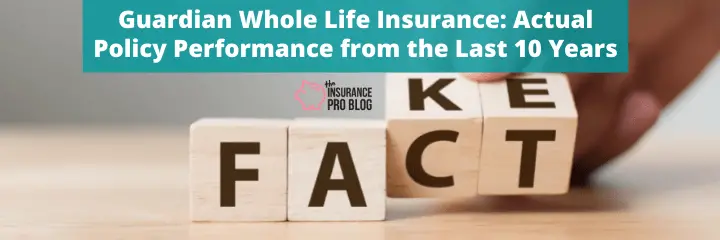Podcast: Play in new window | Download
When buying a whole life policy it's understandable that people want to try and assess how the policy values will perform over the next several years. The illustration provides a projection of values based on the current dividend, which we know will almost certainly be wrong. Other methods used to gain insight on how insurer's products unfolded provide much less solid evidence to predict future values. These include things like company ratings, capitalization, and operational performance. These are nice things to consider, but of relatively little help if one wants to focus in on specifically what to expect to happen to a policy he/she purchases.
Years ago, AM Best and then The Blease Research company sought to provide some insight here with historical projected vs. actual policy values for several major life insurers. These reports offered some, information on how some whole life policies worked out over time, but they were very limited to generic whole life policies and the information insurers were willing to disclose.
Now that we have well over a decade of time under our belts designing and implementing whole life policies specifically used for cash value accumulation, we have data to review that shows us how these policies performed over a considerable stretch of time. This means we can now share this data to look into how various whole life policies faired over the years given changes in economic circumstances and dividend rates.
First up in our series of evaluating real policy performance is the Guardian Life Insurance Company.
Guardian Whole Life Policy Actual Cash Value Performance
We focused on a Guardian whole life policy that used all the critical elements of a policy designed to optimize cash value growth. It's blended with the majority of the premium comprised of paid-up additions.
This policy did veer a bit in terms of the premium amount paid. The policy owner made slight adjustments to the amount paid versus the originally planned premium amount. But we can still use the internal rate of return (IRR) to control for this change and make an assessment on how the policy compares to its original projections. The results are quite interesting.
Originally, the policy projected a 1.66% annualized rate of return at this point in the policy. This means the policy owner anticipated earning 1.66% compounding annually on the premiums paid to the policy. The policy purchase took place a little over 10 years ago. The dividend rate at Guardian declined from around 7% at inception to below 6% today. Despite the change in the dividend, the real IRR achieved on this policy is 1.63%.
Actual Historical Dividends Paid by Guardian
While I don't have a detailed breakdown of each annual dividend payment from the policy outset, I can see the current dividend paid compared to the projected payable dividend from the original illustration. They are quite different.
The current dividend paid is 72% lower than the originally projected dividend payable at this point.
Given the stark difference in dividend payment, it raises the question why the internal rate of return on cash value is so close to the original projection. There are two primary factors at play.
Reasons the Policy Performed as it Did
The use of paid-up additions places less significance on the dividend payment with respect to the development of cash value. This is especially true for the first several years of a whole life policy's existence. The guaranteed interest paid on cash value, which applies to cash value created by PUA's, drives a considerable amount of policy growth during this time. So the change in cash value growth due to the dividend changes is minimal when looking at the overall performance of the policy.
Second, the additional–originally unplanned–payment of paid-up additions helps boost IRR because we are compounding a larger number. Whole life policies do have a fixed amount of expense that will wear slightly on the rate of return. Excess cash a policy has above these fees creates a marginally improved rate of return. Had the policyholder paid premiums as originally planed to date, the actual IRR achieved would likely be less. How much less is difficult to quantify in this case.
Sequence of Return Risk Impact on Whole Life Insurance
While whole life insurance is one of the better shields against sequence of returns risk, it's not completely immune. Changes in the dividend rate will have a greater or lesser impact on policy values depending on when they occur. Changes in the dividend rate early in the policy's lifetime are less impactful while changes later in the lifetime of the policy will be more impactful. This is the case because cash value serves as a basis off which insurers calculate a portion of the dividend.
So while the Guardian dividend did change quite substantially since policy inception, it took place, so far, over the earlier years where the policy had less cash value. If the dividend level remains at its current low levels throughout the next several decades, we can anticipate that the divergence of actual versus originally projected cash value will continue to grow. If, on the other hand, dividend levels rise over this same time period, we might find that projected versus actual cash value performance remains relatively similar.


I see under the reasons the policy performed as it did there was a fairly large omission
Pegging and substitution probably played a large role in the first 4 years.
Whgile ther divs on the adds were not affected the base dividends for the first 4 years were
Hi Jeff, I had considered this. But given how small the base whole life policy is relative to PUA’s, I’d estimate this had a small impact on the policy’s performance.